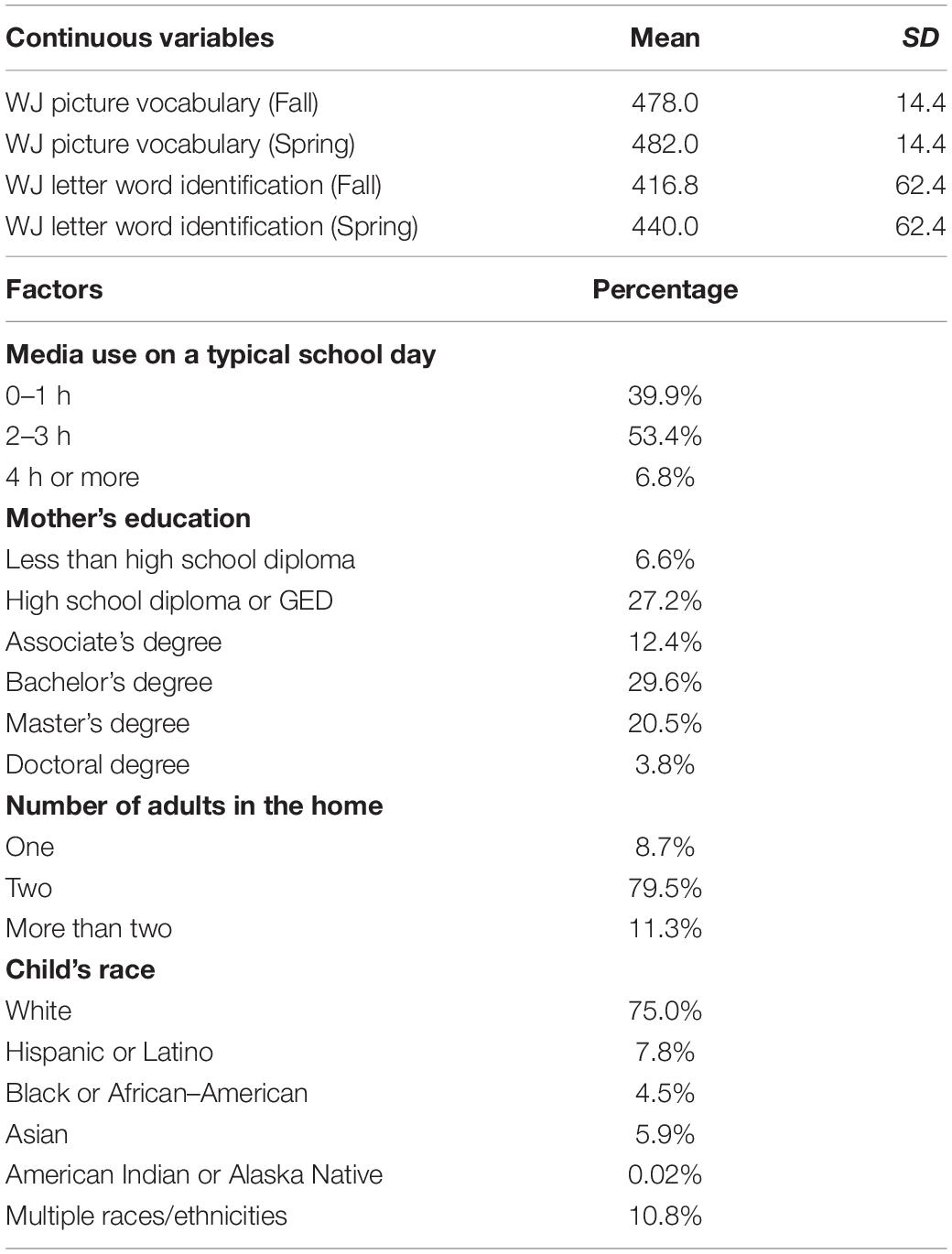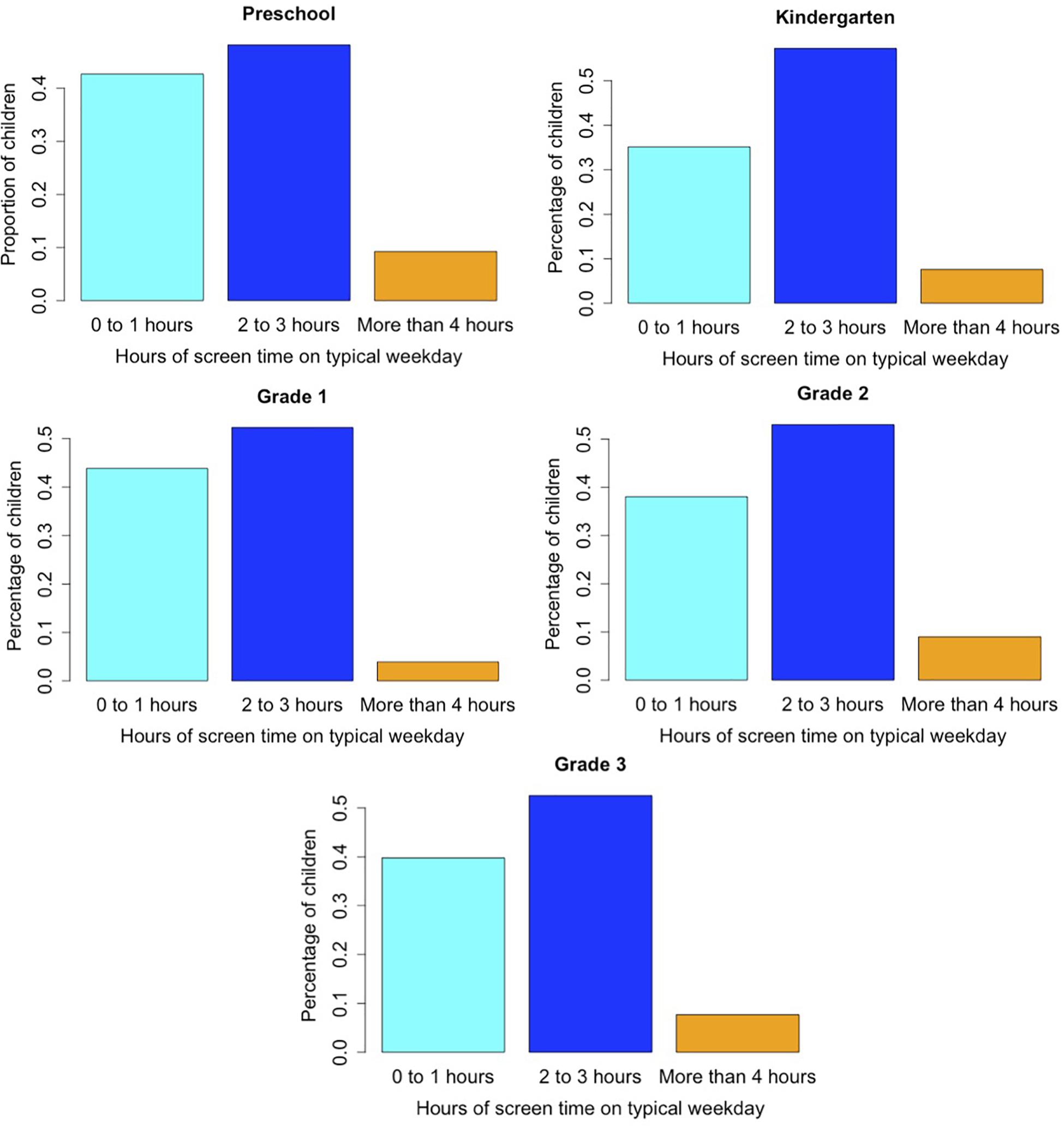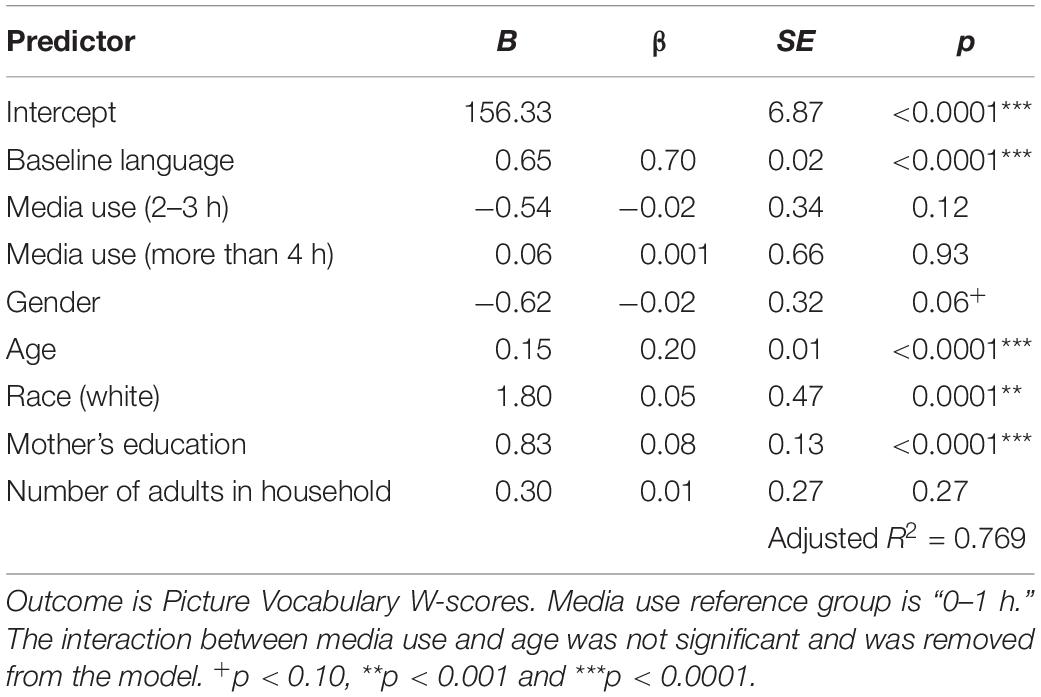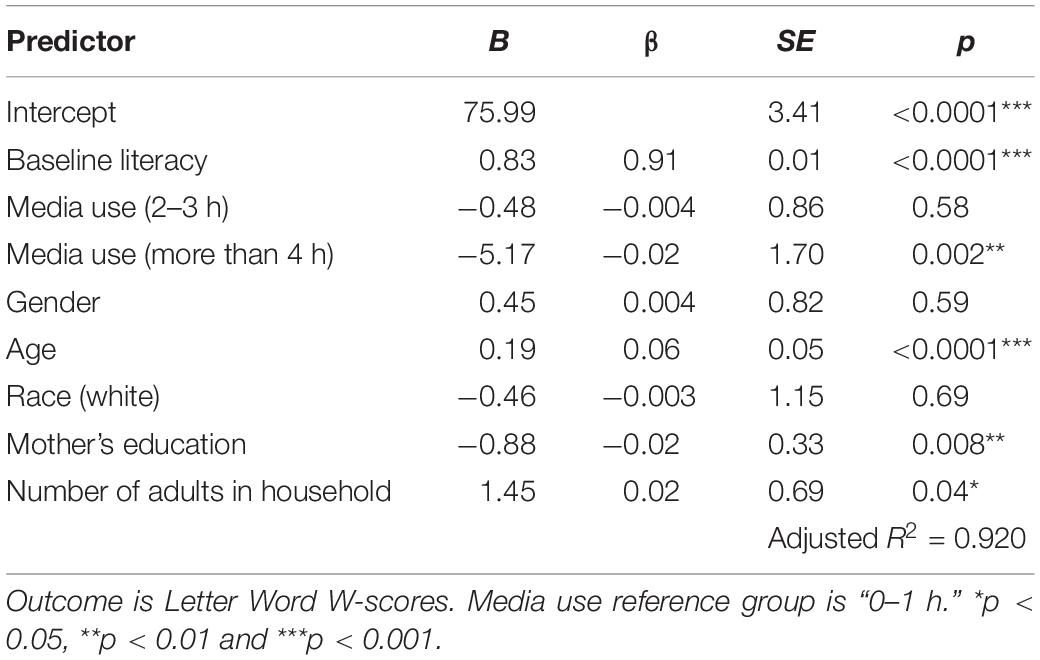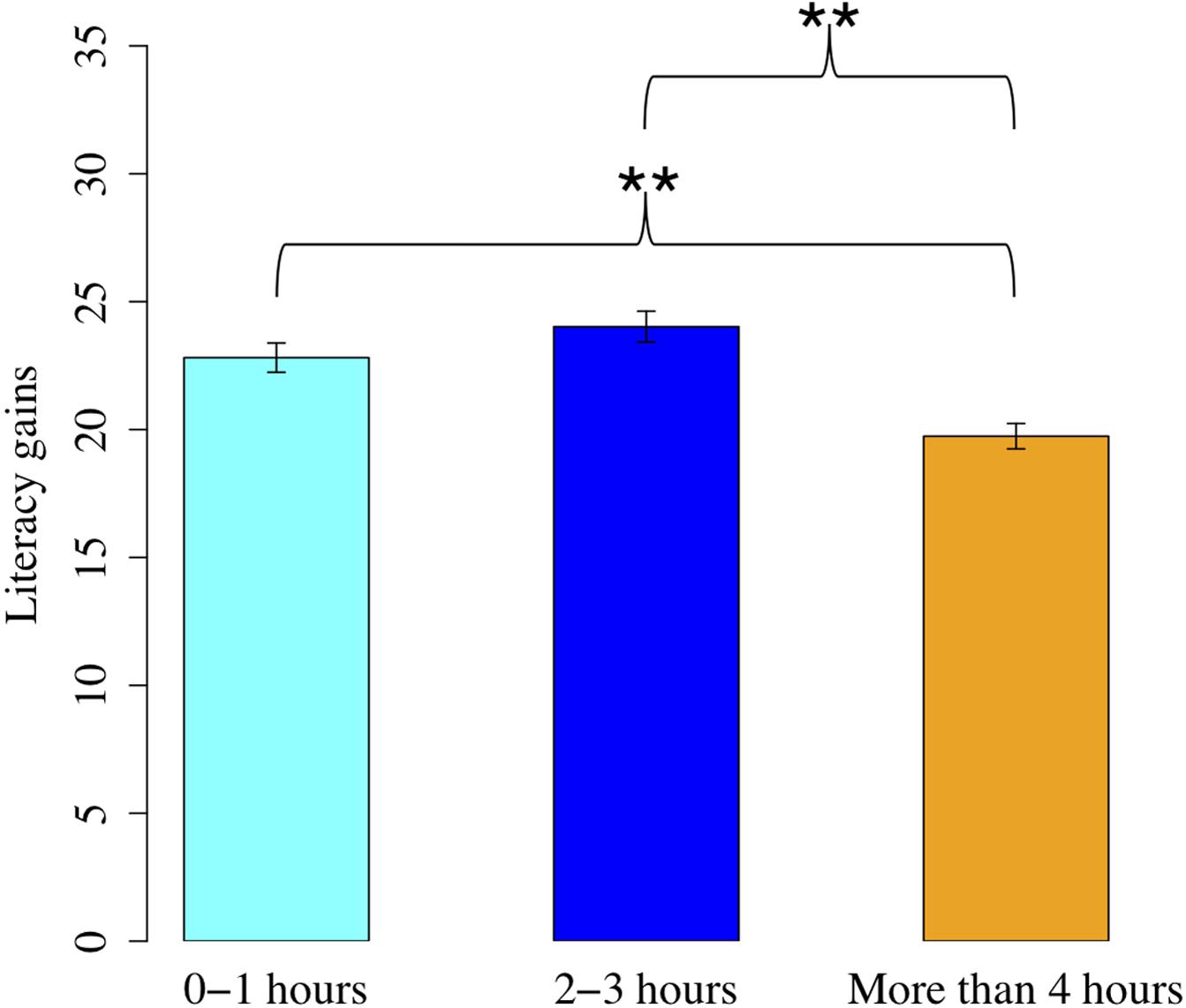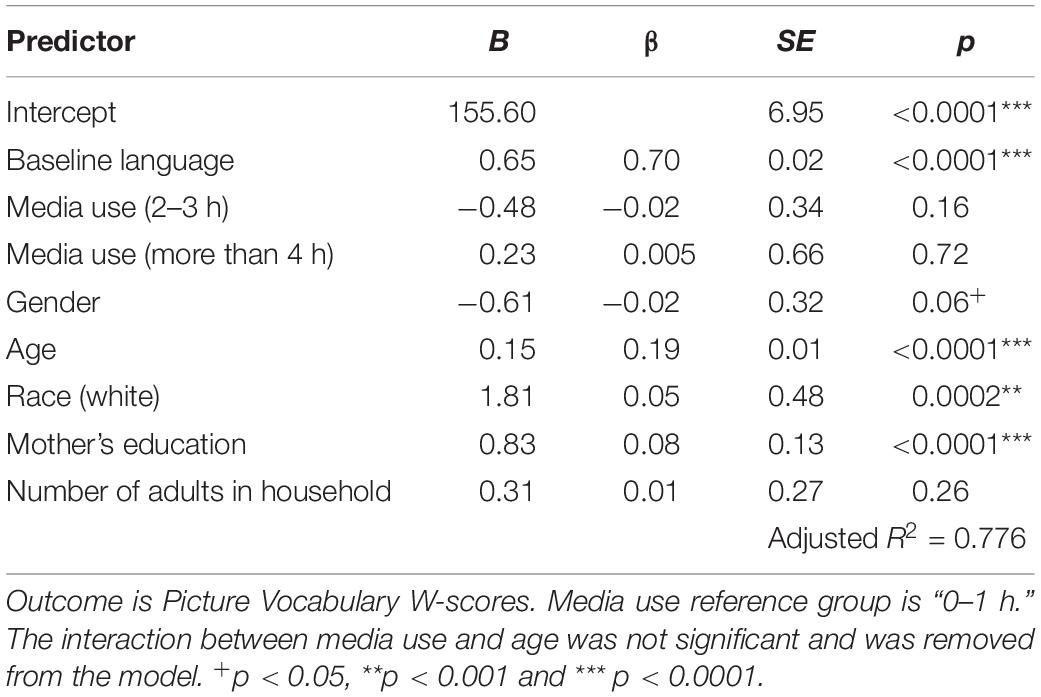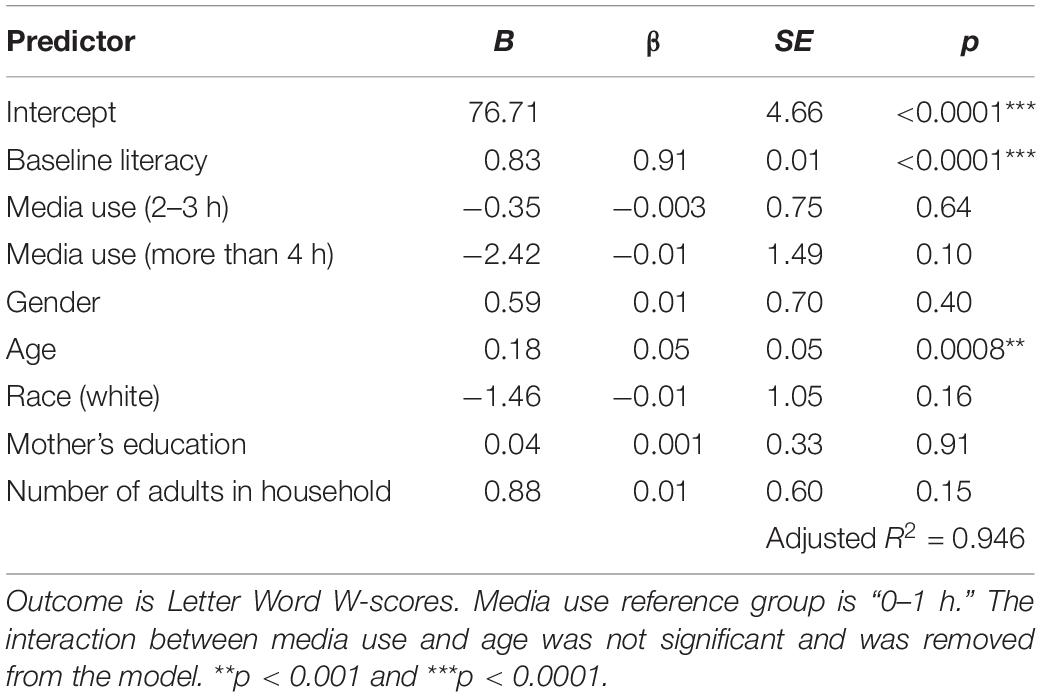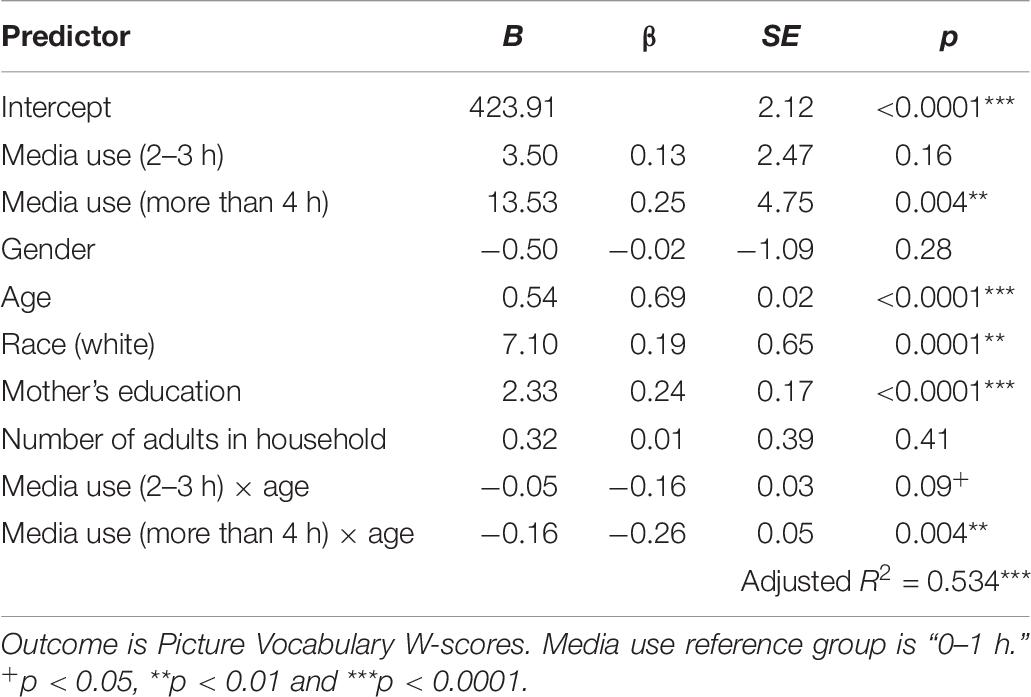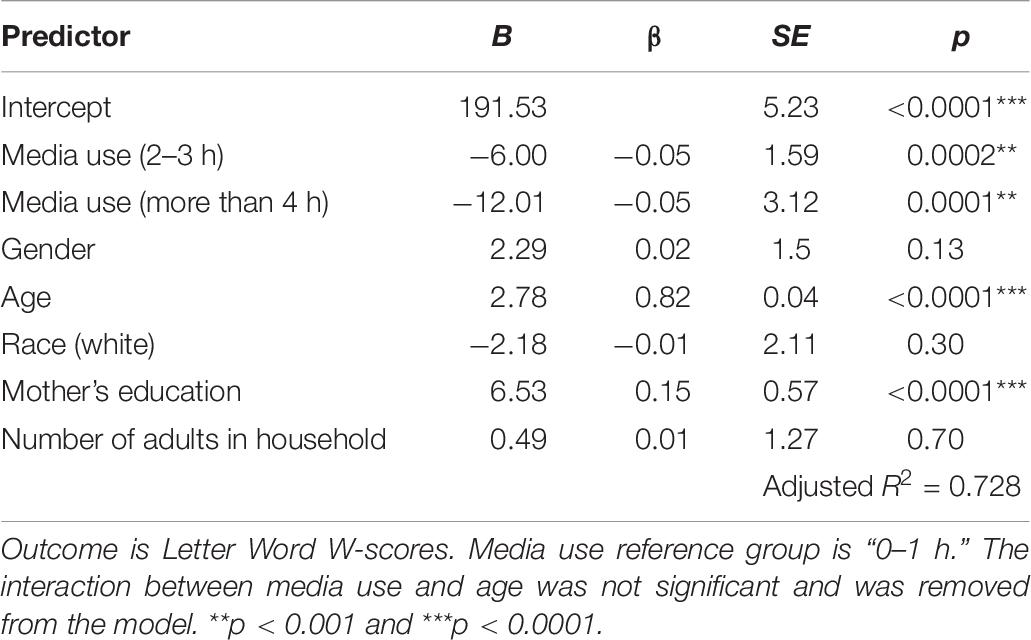- 1Crane Center for Early Childhood Research and Policy, The Ohio State University, Columbus, OH, United States
- 2Department of Educational Studies, The Ohio State University, Columbus, OH, United States
- 3Department of Human Sciences, The Ohio State University, Columbus, OH, United States
Media use is a pervasive aspect of children’s home experiences but is often not considered in studies of the home learning environment. Media use could be detrimental to children’s language and literacy skills because it may displace other literacy-enhancing activities like shared reading and decrease the quantity and quality of caregiver–child interaction. Thus, the current study asked whether media use is associated with gains in children’s language and literacy skills both at a single time point and across a school year and whether age moderates any association. Children (N = 1583) were from preschool through third grade classrooms and language and literacy skills were measured in the fall and spring of the school year. Parents reported how much time their child spends using media on a typical school day. Regression analyses showed that using 4 h or more of media was related to lower literacy gains, but not to language gains. Multilevel models conducted as a robustness check showed that this effect did not hold when accounting for classroom. In neither set of models was there an interaction between age and media use. Single-time-point models did show some associations that did not manifest in more stringent models, highlighting the limitations of correlational designs that do not have measures of children’s skills over time. Given the concern and popular press coverage around children’s media use, it is important to acknowledge non-significant effects in this domain. These non-significant associations suggest that societal fears around children’s media use may be exaggerated. Notably, however, characteristics of children’s media use, like educational content or adult co-use, may moderate any effects. The relation between media use and language and literacy growth did not differ across the age range investigated suggesting that, within this range, younger children are not more vulnerable to detrimental effects.
Introduction
Social-constructivist theories assert that children’s knowledge and skills develop in the context of interactions with others who have more experience, such as parents, caregivers, and other adults (Bruner, 1978). In line with this theoretical tradition, research has shown that the home learning environment, which captures both materials and opportunities for interactions, is linked to child development and learning across domains, including language and literacy (NICHD Early Child Care Research Network, 1999; Barnett et al., 2012; Hirsh-Pasek et al., 2015). Previous research has sought to understand how specific aspects of children’s experiences at home relate to language and literacy skills. For example, the number of picture books in the home and the frequency of parent–child shared reading are related to preschoolers’ language ability (Payne et al., 1994), as is time spent engaging in other educational or enriching activities like talking to adults (Fiorini and Keane, 2014).
However, media use is an increasingly pervasive activity in children’s lives in the 21st century, but it is often not considered in the context of research on the home environment. Children under 8 spend over 2 h a day with media and time spent using mobile devices tripled from 2013 to 2017 (Rideout, 2017). Indeed, children spend more time using media than in any other single leisure activity (Bianchi et al., 2006) and recent evidence suggests that early childhood technology use has increased by 32% in the last two decades (Goode et al., 2019).
Although the frequency of children’s media use is well established, its association with language outcomes is not as well understood. However, some research suggests that media use may be detrimental to children’s language and literacy skills because it may displace other literacy-enhancing activities like shared reading and decrease the quantity and quality of caregiver–child interaction. For example, Khan et al. (2017) found that higher levels of television viewing were associated with lower levels of parent–child book reading among a nationally representative sample of 4-year-olds. Furthermore, both the quantity and quality of caregiver speech and caregiver–child engagement is lower during television viewing compared with free play or other activities (Nathanson and Rasmussen, 2011; Pempek et al., 2011; Lavigne et al., 2015). This is critical because early caregiver–child interactions in the home are highly influential to language development (e.g., Hirsh-Pasek et al., 2015).
In line with these data, several studies have found that media exposure during toddlerhood or preschool is associated with lower language development in subsequent years (Clarke and Kurtz-Costes, 1997; Duch et al., 2013; Pagani et al., 2013). Furthermore, one recent study shows an association between children’s screen media use and lower microstructural integrity of brain white matter in areas related to language and emergent literacy (Hutton et al., 2019). However, findings are inconsistent, with other studies finding no association between media exposure and children’s language development (Patterson, 2002; Taylor et al., 2017; Pence and Alamos, 2019).
Notably, societal and parental concern about potential effects of media use on child development run counter to research showing that media can have some benefits for children. A large body of research shows that by preschool, children can learn from high-quality educational media, including in the domain of language and early literacy skills (e.g., Penuel et al., 2012; Mares and Pan, 2013; Hurwitz, 2018; Dore et al., 2019). There is also evidence that active video games or exergames, like Wii Fit or Just Dance, can increase children’s physical activity and fitness (e.g., Flynn et al., 2018; Gao et al., 2018). Although research is in its early stages, open-ended, multi-player games like Minecraft may also have the potential to promote creativity and collaboration (Lane and Yi, 2017). In line with these ideas, most parents believe that their child benefits from media use, especially in the areas of learning and creativity (Rideout, 2017). Thus, to the extent that families limit media because of concerns about effects on child development, including language and literacy, children may be missing out on positive aspects of media use.
Importantly, much of the literature focusing on the role of media use in language development has focused on infants, toddlers, and preschoolers, with less focus on older children. The preschool years are a time of immense language growth, as there are large increases in neural connections in the prefrontal cortex during this period that are influenced by early experiences (Huttenlocher, 2002). Thus, one might predict that media use would be more detrimental in preschool than during the elementary years. However, parents of 5- to 8-year-olds are even more likely than parents of younger children to believe that their child spends too much time with screen media and are less likely to believe that media use helps their child’s learning (Rideout, 2017), indicating that concerns about screen media use are still prevalent for this age group. Examining the relation between media use and language and literacy development with older children and across a wider age range is important to understand whether any relation is consistent across childhood or whether early childhood is an especially vulnerable time period for possible disruptions to the development of language and literacy skills. Investigating this question in the understudied age range used here (PreK to Grade 3) is particularly important to provide developmentally specific recommendations for parents and caregivers about children’s screen media use. We expect that there will be a stronger association between screen media use and language and literacy skills during early childhood, given rapid growth in these domains during the preschool years.
Another limitation of the existing research is that it focuses largely on vocabulary as an outcome to the exclusion of more comprehensive measures of language and literacy development. Although vocabulary is a vital aspect of language development and is predictive of later reading ability (Cunningham and Stanovich, 1997; Kim, 2016, 2017), letter knowledge and decoding are also necessary components of reading (e.g., Hoover and Gough, 1990; Chen and Vellutino, 1997; Kendeou et al., 2009) and media use may affect these skills via different mechanisms. Theoretically, whereas vocabulary may be affected if media leads to reduced opportunities for adult–child interaction and conversation, literacy skills are more likely to be affected if media displaces shared book reading and other print-focused activities. Thus, it is vital for research to examine multiple aspects of language and literacy development in relation to children’s media use to determine whether there are differential relations between media use and these skills.
Finally, many previous studies have examined the correlation between media use and language skills at one time point (e.g., Clarke and Kurtz-Costes, 1997) or have only an earlier measure of media use and a later measure of language skills (Pagani et al., 2013). Although experimental designs are necessary to draw strong conclusions about causality, using a design with measures of children’s language skills at two time points can begin to further our understanding of potential directionality of influence by controlling for initial levels of language and literacy skills and examining the unique relation between media use and change in these skills over time. Notably, we conduct analyses using both a single time point (i.e., analysis of correlation) and using two time points (i.e., analysis of pre–post changes) to test the extent to which media use was more associated with children’s language and literacy skills at the end of the academic year or the growth of these skills across the academic year.
Thus, the current study addresses four research questions: (1) To what extent is media use associated with gains in the language skills of children in PreK to 3rd grade across the school year? (2) To what extent is media use associated with gains in the literacy skills of children in PreK to 3rd grade across a school year? (3) Does age moderate any association between media use and language and literacy skills? (4) To what extent do the results of models assessing skill gains differ from single-time-point models?
Materials and Methods
Participants
Children from preschool through 3rd grade were recruited via their classroom teachers in two school districts in a Midwestern City in the United States. Every student within each classroom was asked to participate and 66.0% consented. Of the children whose parents consented for them to participate, approximately 74% of families returned the survey that included the media questions to be included in the current analysis. Of those, approximately 77% had data for the variables of interest for the current research questions. Thus, data from 1583 children (PreK n = 238, kindergarten n = 466, grade 1 n = 307, grade 2 = 326, and grade 3 = 246; 49.7% males) are included. Note that the sample size varies slightly for each analysis as a result of variable missingness across assessments, and so on. See Table 1 for sample demographics.
Procedures
Children’s language and literacy skills were directly assessed in the fall and the spring of the academic year. In the spring, caregivers reported on children’s media use, as well as other child and family demographic characteristics.
Measures
Caregiver Report of Child Media Use
As part of a larger family background questionnaire, parents responded to two binary items asking whether their child watched “any kind of video, including TV, movies or short clips on any type of device” and played “games on any type of electronic device” on a typical school day. If parents reported that their child used any media on a typical school day, they were then asked how much time their children spends using media from five response options: 0–1, 2–3, 4–5, 6–7, and 8+ h. For analyses, the last three categories were combined into one category for 4 h or more, given small cell sizes.
Language Skills
To assess language skills, children completed the Picture Vocabulary subtest of the Woodcock Johnson Test of Achievement-III (WJ-III; Woodcock et al., 2007) in the fall and the spring of the school year. The initial items of the subtest require children to choose the picture that fits the named word for the initial items and then later items require children to provide names for each picture (44 items total). Six consecutive correct items are needed to establish test basal and six consecutive incorrect responses terminate the test. Reliability was adequate (0.80) and W-scores were used to examine student growth.
Literacy Skills
To assess literacy skills, children completed the Letter-Word Identification subtest of the Woodcock Johnson Test of Achievement-III (WJ-III; Woodcock et al., 2007) in the fall and the spring of the school year. This subtest (76 items total) requires children to identify individual letters and then read individual words of increasing difficulty. Six consecutive correct items are needed to establish test basal and six consecutive incorrect responses terminate the test. Reliability was adequate (0.94) and W-scores were used to examine student growth.
Demographic Characteristics
Several background demographic characteristics were assessed and included as control variables in our analyses. Specifically, age, gender, race, mother’s education, and number of adults in the household were reported by the caregiver as part of the larger family background questionnaire.
Analysis Plan
We first report descriptive statistics and assess demographic characteristics as predictors of media use to understand the characteristics of children’s media use in the sample. Next, to assess the first two research questions, whether media use was related to gains in children’s language and literacy skills in early and middle childhood, we conduct regression analyses separately for language skills and literacy skills. Children’s spring W-scores are dependent variables and models control for fall scores to assess change. The models also control for age, gender, race, mother’s education, and number of adults in the household. Pursuant to the third research question, whether the relation between media use and children’s language development was moderated by age, we add an interaction between age and media use into the previously described models by multiplying the age and media use variables and examining whether the interaction variable is statistically significant predictor of children’s spring W-scores. Then, although our research questions are at the child level given that recruitment was conducted in classrooms and ICCs indicate that the grade and classroom accounted for a significant portion of the variability in the outcomes of interest (language ICC = 0.56; literacy ICC = 0.84), as a robustness check for our initial models we also conduct multilevel models accounting for classroom, testing for both main effects of media use and interactions with age. Finally, to be able to provide comparable results with previous studies using a single time point, we conduct separate regression analyses predicting children’s spring language and literacy scores from media use, also reported in the spring.
Results
Descriptive Statistics and Predictors of Children’s Media Use
We first report descriptive statistics related to children’s media use. See Table 1 for descriptive statistics for all study variables. Parents reported that 71.5% of children both watch videos and play games on a typical school day, with an additional 22.2% watching video but not playing games and 1.4% playing games but not watching video. Only 4.8% of children were reported to not use any media on a typical school day. Of those children who were reported to use media on a typical school day, 39.4% use media for 0–1 h, 53.0% use media for 2–3 h, and 7.6% use media for 4 h or more (see Figure 1).
Children’s media use was related to mother’s education (ps < 0.0003), with children of mothers with lower education more likely to use 2–3 h or 4 h or more of media on a typical school day. Media use was also related to race (p = 0.04), such that White children were more likely to use 2–3 h of media on a typical school day (54%) than 0–1 h (38%), whereas non-White children were more evenly split between these categories (47 and 43%, respectively). Similarly, boys were more likely to use 2–3 h of media on a typical school day (56%) than 0–1 h (35%), whereas girls were more evenly split between these categories (49 and 44%, respectively). Children with a larger number of adults in the home were more likely to use 2–3 h of media on a typical school day than to use 0–1 h, p = 0.04. Media use was not related to child age, ps > 0.40.
Relation Between Media Use and Language and Literacy Gains
Results of a model predicting children’s language gains showed that there was no association between media use and language gains, ps > 0.11, see Table 2. The interaction was not significant, ps > 0.21.
In the model for literacy, results showed that children who used 4 or more hours of media on a typical school day had significantly smaller literacy gains than children who used 0–1 h of media per day (B = 5.2, p = 0.002) or those who used 2–3 h of media per day (B = 4.7, p = 0.005; see Table 3 and Figure 2). Using media 2–3 h per day was not associated with smaller gains than 0–1 h per day, p = 0.58. As aforementioned, we added an interaction between age and media use into the previously described model to test our third research question. There was no interaction between age and screen media, ps > 0.21.
In the multilevel robustness check model for language, as in the initial model, there was no association between media use and language gains, ps > 0.16, see Table 4. The interaction between age and media use was also not significant, ps > 0.27.
Unlike the initial model, the association between media use and literacy gains was not significant in the multilevel robustness check model, ps > 0.10, see Table 5. We expect that this difference is a result of reduced power in the more stringent model and of the effects of classroom on children’s literacy skills that wash out smaller associations with home media use. The interaction between age and media use was also not significant, ps > 0.54.
Relation Between Media Use and Language and Literacy Skills at a Single Time Point
To address our fourth research question, about the extent to which the results of models assessing skill gains differ from single-time-point models, we examined the association between media use and language skills at a single time point. Results showed a significant interaction (B = −0.16, p = 0.004; see Table 6). Follow-up regression analyses for each age quartile showed that there was only a negative association between media use and language skills for children in the oldest quartile, 99 months (or a little over 8 years) and older, among whom having more than 4 h a day of media use per day was associated with lower language skills than having 0–1 h of media use (B = −4.36, p = 0.03), whereas there was no significant association between media use and language skills for younger children, ps > 0.13.
When examining the association between media use and literacy skills at a single time point, results showed a significant main effect of media use, such that using 2–3 h of media per day was associated with lower literacy scores than using 0–1 h of media use (B = −6.00, p = 0.0002) and using more than 4 h of media per day was associated with lower literacy scores than using either 0 to hours (B = −12.01, p = 0.0001) or 2–3 h (B = 6.01, p = 0.049; see Table 7). The interaction between media use and age was not significant.1
Discussion
This investigation was motivated by mixed findings in previous research, with some studies showing that media use was related to lower language development and others showing no relation. The current study had several strengths, including a large sample and data on children’s language and literacy skills collected at two time points. In our initial gain models, we found that only high levels of media use were related to smaller gains in skills and only for literacy, not for language. Furthermore, a robustness check indicated that even this effect was not strong enough to emerge in a model that accounted for the nested structure of the data. However, in single-time-point models, we found main effects of media use on children’s literacy skills and an interaction between media use and age predicting language skills, such that there was an association only for the older children in our sample.
The discrepancy between the single-time-point and gain models highlights the limitations of correlational designs that do not have measures of children’s skills over time. If we were relying on a single time point, we would draw markedly different conclusions from these data. If children’s media use has a detrimental effect on language and literacy skills, we would expect it to continue to operate and manifest in gains over time. Instead, we find that the effects in the single-time-point models are not significant in the most robust gain models. This suggests that perhaps there is a third variable problem where media use is acting as a proxy for other family or home characteristics that are also associated with children’s language and literacy skills. Accounting for fall scores largely eliminates these associations, leaving only the unique association between media use and language and literacy gains.
Given the concern and popular press coverage around children’s media use, it is important to acknowledge non-significant effects in this domain. There has been fear around the effects of novel technologies and mediums in the past, including concerns about the effects of exposure to early radio shows in the 1920s and moral panic about children reading comic books in the 1950s (Wartella and Jennings, 2000; Tilley, 2012). Although children’s media use in the 21st century may appear extreme and strikingly different from the childhood their parents experienced 30 or 40 years ago, non-significant associations such as those reported here suggest that societal fears around children’s media use may be exaggerated.
Importantly, even in our initial gain models, we only found associations between media use and literacy gains for high levels of use, whereas literacy gains did not differ between more moderate levels of use and low use. These data suggest that any effect of media use on literacy skills may represent a threshold effect, rather than a linear relationship. In addition to the use of single-time-point approaches, this type of relation may explain mixed findings in the literature because analyses testing only for a linear relationship may not be sensitive enough to detect this kind of threshold. Why might this threshold effect exist? One possible explanation is that media use has a negative effect on literacy skills when it is used in large amounts on a daily basis and thus displaces important educational activities like shared book reading and other activities with a print focus. On the other hand, more moderate amounts of media use may be less likely to displace such activities or may not displace them to the extent that it disrupts literacy development. The somewhat small proportion of children falling into the highest category of media use (7.6% using media for 4 or more hours on a typical school day) may contribute to lower power to detect effects of this extreme amount of use in our robustness check models.
Given previous findings suggesting that media use can displace important language- and literacy-enhancing activities, the non-significant effects reported here are somewhat surprising. However, there are several possible explanations for these findings. Importantly, media use is not monolithic, and some media experiences could be more supportive of language development than others (Linebarger and Vaala, 2010; Dore et al., 2017). We measured only quantity of media use but features of that media use may moderate any effects on language development. First, the relation between media and language development may depend on how much adults engage with children during media use. In other words, the role that media use plays in a child’s language and literacy development may differ depending on whether she primarily uses media by herself or whether most of her media use involves a caregiver using and discussing media with her. When this type of joint media engagement is frequent, language and literacy development may be more positive because the media experience does not replace caregiver–child interaction and instead extends it to a new context. Second, given the importance of joint attention and serve-and-return responding to language development (e.g., Tomasello and Farrar, 1986), it may be significant that some types of media are themselves interactive. That is, digital games and apps can be responsive to the child’s actions in a way that a television show is not (Sheehan and Uttal, 2016). Although the interactivity afforded by digital devices is less flexible and responsive than a caregiver might be, the proportion of children’s media use that includes interactive rather than non-interactive media may differentially predict language and literacy skills because children are more likely to be actively engaged when media uses interactive features. Third, educational media may be more supportive of language and literacy development than content that is intended primarily for entertainment, as research suggests that children can learn from high-quality television (Mares and Pan, 2013). Because most previous research and the current study focus solely on quantity of media use and do not allow for an examination of these factors, null effects and conflicting findings may mask important effects that would emerge when these moderators are considered.
Another possible contributor to these findings relates to the age range of our sample. Most previous research that has found negative relations between media use and language development has been conducted with younger children. Media use may not displace the same activities for older children as it does for toddlers and younger preschoolers. For younger children, media use may most commonly displace activities like storybook reading and parent–child interaction, whereas for older children who are becoming more independent, it may be more likely to displace peer and independent play which are likely to be less important for language and literacy development. In line with this idea, a recent study showed that media use was associated with lower physical activity among 6- to 11-year-olds but not with time for unstructured play (Goode et al., 2019).
An important contribution of the current study is that we used a wide age range, including older children than have typically been studied in past research in this domain. Many of the previous studies have focused on infants and toddlers, and little research has investigated the relation between media use and language and literacy for children in the early elementary grades. Our findings show that the inverse relation between these variables may not extend to this older age range, perhaps because early childhood is a more sensitive time for language development. Notably, we also found that the relation between media use and language and literacy growth did not differ across the age range investigated (PreK to 3rd grade), suggesting that any effects in early childhood may be restricted to toddlers and the early preschool years.
Although we find non-significant relations between media use and language and literacy skills in our most robust models, there may be detrimental effects of media use in other domains. For example, children’s media use, and evening media in particular, has been associated with increased sleep problems and changes in sleep patterns (Garrison et al., 2011; Beyens and Nathanson, 2019). Some studies also find that preschoolers’ media use is correlated with lower social skills (Hinkley et al., 2018) and executive function skills (Nathanson et al., 2014). It will be important for future research to investigate the relation between media use and other domains of child development. Furthermore, although we had a large and somewhat diverse sample, we did not have data for all of the children in our sample because of missing surveys and items, and our findings may not generalize to other populations. Future research should investigate these relations in a representative sample of children and families.
Although additional research is needed to further elucidate the role that media plays in child development, the current findings suggests that, at least by PreK and for language and literacy skills, any role of media use in children’s development is likely to be small at most. There may be important moderators that were not examined here, such that certain types of media use or media use in certain contexts may be more strongly associated with children’s skills. Importantly, children may also benefit from some media use, such as video games and exergames (Blumberg et al., 2019), and overgeneralizations that demonize media use could lead to children missing out on valuable opportunities for media to contribute to positive aspects of their lives. Given its prevalence in children’s lives, media use is a fundamental aspect of the home environment and it will be important for future research to investigate how it relates to both other aspects of the home environment and to children’s developing skills.
Data Availability Statement
The raw data supporting the conclusions of this article will be made available by the authors, without undue reservation, to any qualified researcher.
Ethics Statement
The studies involving human participants were reviewed and approved by The Ohio State University Institutional Review Board. Written informed consent to participate in this study was provided by the participants’ legal guardian/next of kin.
Author Contributions
LJ, KP, T-JL, and JL contributed to conceptualization of the larger project and obtained funding. RD and JL contributed to the conceptualization of the current study and conducted data analyses. RD drafted the work. JL, LJ, KP, and T-JL contributed to editing and revising and gave final approval of the version to be submitted. All authors contributed to the article and approved the submitted version.
Funding
The research reported here was supported by Institute of Education Sciences, through Grant R305N160024 awarded to The Ohio State University (LJ).
Disclaimer
The opinions expressed are those of the authors and do not represent views of the Institute or National Center for Education Research.
Conflict of Interest
The authors declare that the research was conducted in the absence of any commercial or financial relationships that could be construed as a potential conflict of interest.
Acknowledgments
We would like to thank the research team, staff, and families without whom this research would not have been possible.
Footnotes
- ^ These models were also conducted as multilevel models accounting for classrooms and results were similar.
References
Barnett, M. A., Gustaffson, H., Deng, M., Mills-Koonce, W. R., and Cox, M. (2012). Bidirectional associations among sensitive parenting, language development, and social competence. Infant Child Dev. 21, 374–393.
Beyens, I., and Nathanson, A. I. (2019). Electronic media use and sleep among preschoolers: evidence for time-shifted and less consolidated sleep. Health Commun. 34, 537–544. doi: 10.1080/10410236.2017.1422102
Bianchi, S. M., Robinson, J. P., and Milke, M. A. (2006). The Changing Rhythms of American Family Life. New York, NY: Russel Sage Foundation.
Blumberg, F. C., Deater-Deckard, K., Calvert, S. L., Flynn, R. M., Green, C. S., Arnold, D., et al. (2019). Digital games as a context for children’s cognitive development: research recommendations and policy considerations. Soc. Policy Rep. 32, 1–33. doi: 10.1002/sop2.3
Bruner, J. (1978). The role of dialogue in language acquisition. The Child’s Conception of Language, 241–256.
Chen, R. S., and Vellutino, F. R. (1997). Prediction of reading ability: a cross–validation study of the simple view of reading. J. Lit. Res. 29, 1–24.
Clarke, A. T., and Kurtz-Costes, B. (1997). Television viewing, educational quality of the home environment, and school readiness. J. Educ. Res. 90, 279–285. doi: 10.1080/00220671.1997.10544584
Cunningham, A. E., and Stanovich, K. E. (1997). Early reading acquisition and its relation to reading experience and ability 10 years later. Dev. Psychol. 33:934. doi: 10.1037//0012-1649.33.6.934
Dore, R. A., Shirilla, M., Hopkins, E., Collins, M., Scott, M., Schatz, J., et al. (2019). Education in the app store: using a mobile game to support U.S. preschoolers’ vocabulary learning. J. Child. Media 13, 452–471. doi: 10.1080/17482798.2019.1650788
Dore, R. A., Zosh, J. M., Hirsh-Pasek, K., and Golinkoff, R. M. (2017). “Plugging into word learning: the role of electronic toys and digital media in language development,” in Cognitive Development In Digital Contexts, eds F. Blumberg and P. Brooks (Waltham, MA: Elsevier), 75–91.
Duch, H., Fisher, E. M., Ensari, I., Font, M., Harrington, A., Taromino, C., et al. (2013). Association of screen time use and language development in hispanic toddlers: a cross-sectional and longitudinal study. Clin. Pediatr. 52, 857–865. doi: 10.1177/0009922813492881
Fiorini, M., and Keane, M. P. (2014). How the allocation of children’s time affects cognitive and noncognitive development. J. Lab. Econ. 32, 787–836.
Flynn, R. M., Staiano, A. E., Beyl, R., Richert, R. A., Wartella, E., and Calvert, S. L. (2018). The influence of active gaming on cardiorespiratory fitness in black and Hispanic youth. J. Sch. Health 88, 768–775. doi: 10.1111/josh.12679
Gao, Z., Zeng, N., Pope, Z. C., Wang, R., and Yu, F. (2018). Effects of exergaming on motor skills competence, perceived competence, and physical activity in preschool children. J. Sport Health Sci. 8, 106–113.
Garrison, M. M., Liekweg, K., and Christakis, D. A. (2011). Media use and child sleep: the impact of content, timing, and environment. Pediatrics 128, 29–35. doi: 10.1542/peds.2010-3304
Goode, J. A., Fomby, P., Mollborn, S., and Limburg, A. (2019). Children’s Technology Time in Two US Cohorts. Child Indic. Res. 13, 1107–1132.
Hinkley, T., Brown, H., Carson, V., and Teychenne, M. (2018). Cross sectional associations of screen time and outdoor play with social skills in preschool children. PLoS One. 13:e0193700. doi: 10.1371/journal.pone.0193700
Hirsh-Pasek, K., Adamson, L. B., Bakeman, R., Owen, M. T., Golinkoff, R. M., Pace, A., et al. (2015). The contribution of early communication quality to low-income children’s language success. Psychol. Sci. 26, 1071–1083.
Hurwitz, L. B. (2018). Getting a read on ready to learn media: a meta-analysis review of effects on literacy. Child Dev. 90, 1754–1771.
Huttenlocher, P. R. (2002). Neural Plasticity: The Effect of Environment on the Development of Cerebral Cortex. Cambridge, MA: Harvard University Press.
Hutton, J. S., Dudley, J., Horowitz-Kraus, T., DeWitt, T., and Holland, S. K. (2019). Associations between screen-based media use and brain white matter integrity in preschool-aged children. JAMA Pediatr. 2019:e193869.
Kendeou, P., Van den Broek, P., White, M. J., and Lynch, J. S. (2009). Predicting reading comprehension in early elementary school: the independent contributions of oral language and decoding skills. J. Educ. Psychol. 101:765. doi: 10.1037/a0015956
Khan, K. S., Purtell, K. M., Logan, J., Ansari, A., and Justice, L. M. (2017). Association between television and parent-child reading in the early home environment. J. Dev. Behav. Pediatr. 38, 521–527. doi: 10.1097/DBP.0000000000000465
Kim, Y. S. G. (2016). Direct and mediated effects of language and cognitive skills on comprehension of oral narrative texts (listening comprehension) for children. J. Exp. Child Psychol. 141, 101–120. doi: 10.1016/j.jecp.2015.08.003
Kim, Y. S. G. (2017). Why the simple view of reading is not simplistic: Unpacking component skills of reading using a direct and indirect effect model of reading (DIER). Sci. Stud. Read. 21, 310–333. doi: 10.1080/10888438.2017.1291643
Lane, H. C., and Yi, S. (2017). Playing with virtual blocks: minecraft as a learning environment for practice and research. Cogn. Dev. Digi. Context. 2017, 145–166.
Lavigne, H. J., Hanson, K. G., and Anderson, D. R. (2015). The influence of television coviewing on parent language directed at toddlers. J. Appl. Dev. Psychol. 36, 1–10. doi: 10.1016/j.appdev.2014.11.004
Linebarger, D. L., and Vaala, S. E. (2010). Screen media and language development in infants and toddlers: an ecological perspective. Dev. Rev. 30, 176–202. doi: 10.1016/j.dr.2010.03.006
Mares, M.-L., and Pan, Z. (2013). Effects of sesame street: a meta-analysis of children’s learning in 15 countries. J. Appl. Dev. Psychol. 34, 140–151. doi: 10.1016/j.appdev.2013.01.001
Nathanson, A. I., Aladé, F., Sharp, M. L., Rasmussen, E. E., and Christy, K. (2014). The relation between television exposure and executive function among preschoolers. Dev. Psychol. 50:1497. doi: 10.1037/a0035714
Nathanson, A. I., and Rasmussen, E. E. (2011). TV viewing compared to book reading and toy playing reduces responsive maternal communication with toddlers and preschoolers. Hum. Commun. Res. 37, 465–487. doi: 10.1111/j.1468-2958.2011.01413.x
NICHD Early Child Care Research Network (1999). Child care and mother-child interaction in the first 3 years of life. Dev. Psychol. 35, 1399–1413. doi: 10.1037/0012-1649.35.6.1399
Pagani, L. S., Fitzpatrick, C., and Barnett, T. A. (2013). Early childhood television viewing and kindergarten entry readiness. Pediatr. Res. 74, 350–355. doi: 10.1038/pr.2013.105
Patterson, J. L. (2002). Relationships of expressive vocabulary to frequency of reading and television experience among bilingual toddlers. Appl. Psycholinguist. 23, 493–508.
Payne, A. C., Whitehurst, G. J., and Angell, A. L. (1994). The role of home literacy environment in the development of language ability in preschool children from low-income families. Early Childh. Res. Q. 9, 427–440.
Pempek, T. A., Demers, L. B., Hanson, K. G., Kirkorian, H. L., and Anderson, D. R. (2011). The impact of infant-directed videos on parent-child interaction. J. Appl. Dev. Psychol. 32, 10–19. doi: 10.1016/j.appdev.2010.10.001
Pence, K., and Alamos, P. (2019). “Electronic media use profiles and school readiness competencies for preschoolers from low-income backgrounds,” in Poster Presented At The Biennial Meeting Of The Society For Research In Child Development, Baltimore, MD.
Penuel, W. R., Bates, L., Gallagher, L. P., Pasnik, S., Llorente, C., Townsend, E., et al. (2012). Supplementing literacy instruction with a media-rich intervention: results of a randomized controlled trial. Early Childh. Res. Q. 27, 115–127. doi: 10.1016/j.ecresq.2011.07.002
Rideout, V. (2017). The Common Sense Census: Media Use By Kids Age Zero To Eight. San Francisco, CA: Common Sense Media.
Sheehan, K. J., and Uttal, D. H. (2016). Children’s learning from touch screens: a dual representation perspective. Front. Psychol. 7:1220. doi: 10.3389/fpsyg.2016.01220
Taylor, G., Monaghan, P., and Westermann, G. (2017). Investigating the association between children’s screen media exposure and vocabulary size in the UK. J. Child. Media 12, 51–65. doi: 10.1080/17482798.2017.1365737
Tilley, C. L. (2012). Seducing the innocent: fredric wertham and the falsifications that helped condemn comics. Inf. Cult. 47, 383–413. doi: 10.1353/lac.2012.0024
Wartella, E. A., and Jennings, N. (2000). Children and computers: new technology. old concerns. Future Child. 10, 31–43.
Keywords: media, language, literacy, screen time, children
Citation: Dore RA, Logan J, Lin T-J, Purtell KM and Justice LM (2020) Associations Between Children’s Media Use and Language and Literacy Skills. Front. Psychol. 11:1734. doi: 10.3389/fpsyg.2020.01734
Received: 31 March 2020; Accepted: 23 June 2020;
Published: 05 August 2020.
Edited by:
Frank Niklas, Ludwig Maximilian University of Munich, GermanyCopyright © 2020 Dore, Logan, Lin, Purtell and Justice. This is an open-access article distributed under the terms of the Creative Commons Attribution License (CC BY). The use, distribution or reproduction in other forums is permitted, provided the original author(s) and the copyright owner(s) are credited and that the original publication in this journal is cited, in accordance with accepted academic practice. No use, distribution or reproduction is permitted which does not comply with these terms.
*Correspondence: Rebecca A. Dore, ZG9yZS4xM0Bvc3UuZWR1
 Rebecca A. Dore
Rebecca A. Dore Jessica Logan
Jessica Logan Tzu-Jung Lin
Tzu-Jung Lin Kelly M. Purtell
Kelly M. Purtell Laura M. Justice
Laura M. Justice